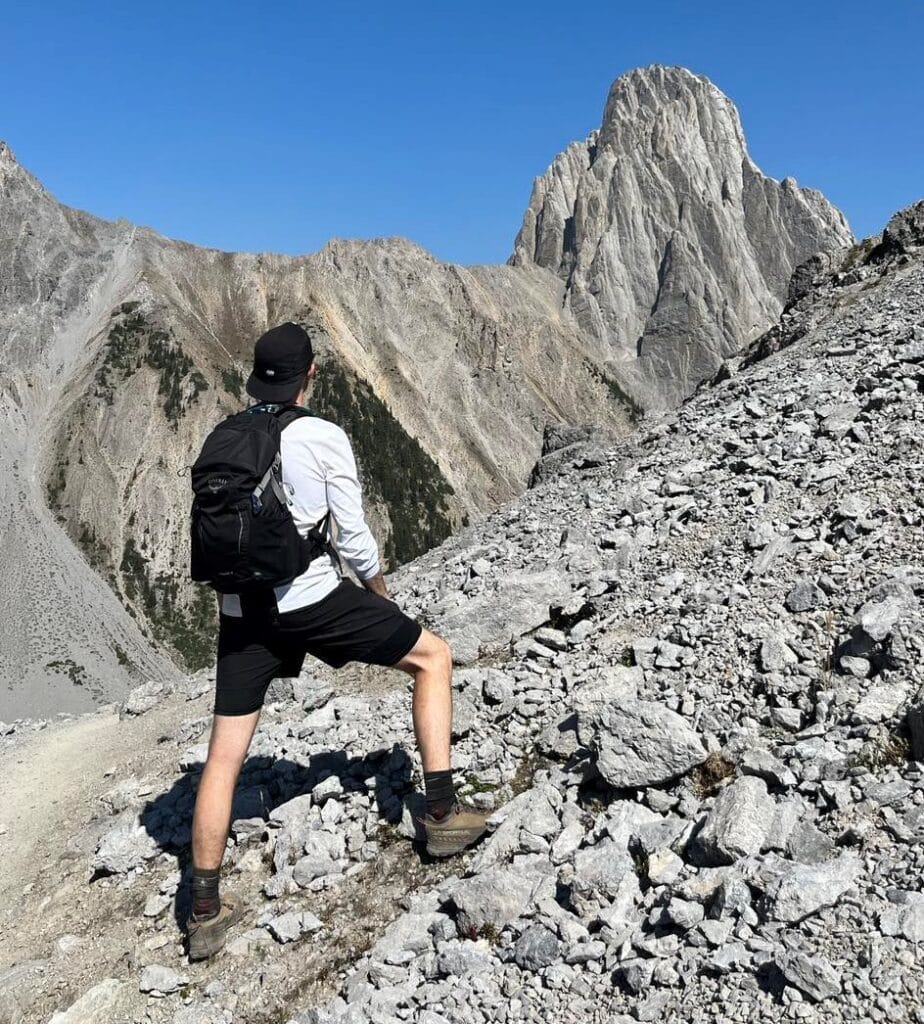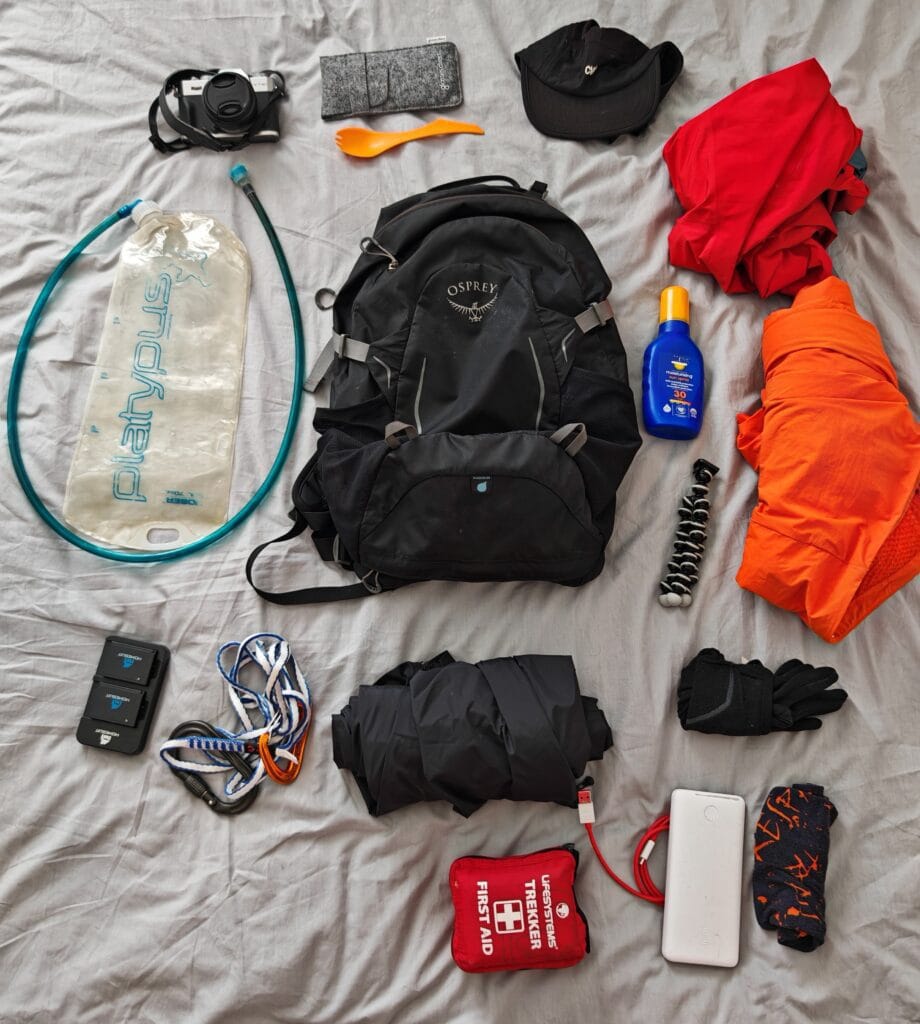Hiking is beautifully simple where all you need are shoes, a backpack and yourself. The most important piece of kit is the hiking shoes or boots. Then, comes the daypack to carry the essentials which will keep you fuelled, dry and safe on your explorations. This Hiking Kit List is my tried and tested packing checklist for mountain adventures with the gear being upgraded every few years. As a result, the packing list was developed over years of hikes included in The Best Mountain Day Hikes and The Best Mountain Hikes 2.0 posts. In particular, the essential gear is highlighted in italics and a few optional items are included.
Disclaimer – NONE of the product links on this hiking kit list are affiliated. They are linked to the Kit supplier’s website where possible for your convenience. Therefore, it’s best to shop around to find a bargain and the lowest price in your region.

Hiking Kit List: Daypack Checklist


Essential Equipment
- Backpack – Osprey Hikelite 18
The workhorse on a day hike for me! The Osprey has great back ventilation, and good hip and chest straps to spread the load. For me, 18 litres is the ideal capacity to carry the minimal kit with 2 litres of water and not feel weighed down. Additionally, it has a great rain cover integrated into the bottom which keeps your kit dry. - Hydration Bladder – Platypus Hoser 2L
I prefer a bladder to a water bottle due to the easier hydration on the trail and is lighter than a metal 2L bottle. Naturally, a bladder lasts longer even if it can warm up quicker than a bottle. Recently, I upgraded the Platypus with the Gregory 3D Hydro 3 litres but have yet to try it out. - First Aid Kit – Life Systems Trekker
Luckily I have never used a 1st Aid Kit much so this compact kit sits in the backpack bottom. It includes a space blanket, bandages, scissors, plasters, medicine, burns and blister plasters. Ultimately, it’s worth one person in a hiking group having a 1st Aid kit just in case. - Carabiners – Petzl Attache
A recent addition from my climbing kit bag as it’s handy to snap a cap onto your backpack and for use with a Sling. Either a snap gate or screw gate carabiner can help with camping and clipping light items on too. - Sun cream – Pretty self-explanatory, you don’t want to burn with the increased UV and Glare up mountains
- Sunglasses – Prescription or Goodr OG Running Sunglasses
I always pack in sunglasses to help with the increased UV levels when hiking. My choice is dependent on wearing contact lenses or not. I use the Goodr sunglasses without a prescription when wearing contacts; they have a great stable fit and look great.
Optional Equipment
- Hiking Poles – Leki Makula AS (Optional for Hiking)
I used to use poles on every hike and these Lekis have soft anti-shock suspension to absorb the force, comfortable grips and a good locking system. They aren’t the slightest but are reliable and collapse telescopically. Hiking poles will help propel you uphill and take some strain when descending. - Pen-knife – Victorinox Swiss Card Lite (Optional)
Similarly to the 1st Aid kit, it is not used very often but is a handy tool to carry. Occasionally, I use a Victorinox Hiker Swiss Army Knife as it has a screwdriver, larger blade, a saw and better bottle opener but does weigh more than the Card Lite. - Head torch – Petzl Tikkina (Optional)
Especially for sunrise or night-time hikes, this compact 300-lumen single-banded headtorch with great battery life has saved me on a few pitch-black trails. - Sling – Mammut 120cm Sling (Optional)
Due to a trekking experience where a sling was very useful in escaping a sticky situation and helped avoid any injuries; this item has been added and acts like a looped rope.
Clothing
- Shoes – La Sportiva TX4 Approach Shoes
Simply the best-engineered shoes I own! I love these approach shoes and have never been let down by them. Amazing on rock, Gore-tex waterproofing, great lace system, incredibly comfortable and looks fantastic too. Whether it’s approach shoes or traditional boots, having hiking footwear is a MUST. Ideally, a Vibram sole to help with grip and protect your soles. - Waterproof Jacket – Arc’teryx Beta AR
Having recently replaced my North Face Apex Flex Gore-Tex jacket, the Arc’teryx is an expensive upgrade but worth the investment so far. The Beta AR is a lightweight, packable, highly versatile GORE-TEX PRO shell with a hybrid construction. For any hiking, a good quality waterproof is essential as the mountains are unpredictable. - Waterproof Trousers – Montane Dynamo
Less essential than a Jacket but they can stop you from having wet legs. I prefer to wear pull-over trousers instead of fully waterproof trousers next to the skin. These Montanes are super lightweight, breathable, packable waterproof trousers. - Mid Layer– Arc’teryx Proton Lightweight Hoody
The key to comfortable hiking is layers and a good mid-layer helps you manage heat and the weather. For years I used Trespass micro-fleeces as these were light and warm then a North Face full zip fleece jacket. Now this Arc’teryx has a synthetic down with water water-resistant outer and the comfiest inner lining! It’s designed to be a lightweight, insulated, air-permeable softshell for summer alpine and rock climbing and my go-to outer! - Cap – Ciele Athletics ALZCap
I recommend a hat or baseball cap to help keep the sun off your face or neck. I like the Ciele hats because of the high breathability, UV protection, foldability and clean design. - Gloves – Montane Power Stretch Pro
Even in summer, it can get cold in the mountains if the wind picks up or at higher elevations. Gloves also help when using hiking poles too. - Buff – Trespass (Optional)
A versatile item which can act as a neck warmer, bandana, wristband, balaclava or cap.
Technology
- Camera – Fujifilm X-T30 Mirrorless (Optional)
For years, I used my phone as my primary camera with some incredible photos from Nepal and Canada. However, I’ve recently enjoyed using a Mirrorless camera to capture my travels. The Fujifilm X-T30 is a fantastic compact travel camera that I use with a 15-45mm lens. - Spare Batteries – Homesuit NP-W126/ NP-W126S Battery 1400mah and Dual USB Charger
In comparison, one disadvantage of Mirrorless cameras vs DSLR cameras is the reduced battery life so it’s worth keeping an extra battery with you to swap out. - Tripod – Joby GorrilaPod 1K Kit (Optional)
I haven’t used this small flexible tripod much on my adventures but it is super light and takes up little space. - Power Bank – Anker 325
You never know when you might need a charger to top up a phone, watch or camera. It adds some weight but the Anker can give 4 full charges. A smaller 1 charge powerband would be better with a heavy backpack. - Wallet – Cash, Credit Cards and ID are needed to get transport or food/drink.
- Phone – I love hiking to escape technology and be out in nature. But let’s be honest, it’s unlikely we will be leaving our phones at home for a whole day. My main uses on a day hike are for the camera, emergency calls and for checking transport to and from the trailhead.
Food & Drink
- Lunch – My usual lunch is pasta-based in a Tupperware to give good energy for the afternoon of hiking. Along with some crisps and fruit & nuts to keep me fuelled properly.
- Energy Bars & Gels – Nature Valley bars are my go-to snack and I have tried MyProtein bars to give additional Protein on the trail. I usually carry an energy gel in an emergency if a boost is needed.
- Hydration Tablets and Water – I use High 5 Zero electrolyte tablets in the Hydration Bladder to maintain hydration throughout the day. I tend to drink 2 litres on average a day but more at higher altitudes.
- Spork – Sea to Summit Delta – A cheap and well-made plastic spork with a different design that has a knife on the handle instead of the side of the fork element.
Hiking Kit List: Packing Tips
When packing my Osprey Hikelite, I always fill the hydration bladder and put that in first. Next, I load in the gear I will less likely need such as 1st Aid kit, power banks, tripod, headtorch and waterproof trousers. Then the lunch Tupperware with other snacks around it with buff, sunglasses, sun cream and gloves on either side. Afterwards, I put the camera on top of the food and pack the mid-layer around it. Finally, the last gear to pack is waterproof right at the top for quick and easy access. In the top zip pocket is my wallet, keys, pen-knife, spork, spare camera battery and energy gel.
Clothing: Cold Weather


Hiking Kit List
- Shoes – La Sportiva TX4 Approach Shoes
- Socks – SmartWool / Bridgedale
- Waterproof Jacket – Arc’teryx Beta AR
- Down Jacket – Rab Microlight Alpin
- Waterproof Trousers – Montane Dynamo
- Mid Layer– Arc’teryx Proton
- Beanie – Fjallraven
- Trousers – Montane Terra Pants
- Top – Peak Performance Long Sleeve
- Gloves – Montane Power Stretch Pro
- Mountain Gloves – Mountain Equipment
- Buff – Trespass
- Neck Gaiter – Peak Performance (Optional)
This outfit was tried and tested in Nepal at -25°C at over 5000m in altitude and worked very effectively! The only kit I did not include was Icebreaker Merino wool base layers (long sleeve top and long johns) as these are only for extremely cold days! Alternatively, I use Smartwool merino sock liner for additional warmth. In general, these layers allow you to react if the weather changes and heats up throughout the day and can fit into your backpack with some neat packing.
Clothing Warm Weather


Hiking Kit List
- Shoes – La Sportiva TX4
- Socks – SmartWool
- Shorts- Patagonia
- T-Shirt / Top – Peak Performance
- Cap – Ciele Athletics
- Sunglasses – Goodr
- Contact Lenses (Optional)
This summer outfit is much simpler and focuses on lightweight clothes and sun protection. Frequently, I use double-layer sports or running shorts instead of hiking shorts. Additionally, I have various other tops with the long-sleeved white Peak performance often used in the warm weather with the sleeves rolled. I suggest having lighter hiking socks in summer to avoid your feet overheating (I learnt that the hard way).
What is the must-bring kit for you on a day hike? Is there anything I could add to the hiking kit list? Please comment below and suggestions and share with fellow hikers!
Pingback: Top Benefits of the Arc'teryx Proton LT Hoody Reviewed - Backpacker's Mentality
Pingback: Arc'teryx Beta AR: The Best Waterproof Jacket - Backpacker's Mentality
Pingback: What are the Best Trails in Lynn Canyon and Peak? - Backpacker's Mentality
Pingback: The Ultimate Guide to Montane Terra Pants: Features and Benefits - Backpacker's Mentality
Pingback: Ultimate Tips for New Campers: The Joys of Camping - Backpacker's Mentality
Pingback: Ciele ALZCap: What makes it a Must-have for Runners? - Backpacker's Mentality
Pingback: What Are the Best Zermatt Hikes Near the Matterhorn? - Backpacker's Mentality
Pingback: Scarpa Mescalito Planet: The Best Approach Shoes - Backpacker's Mentality